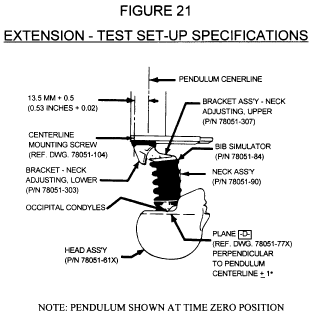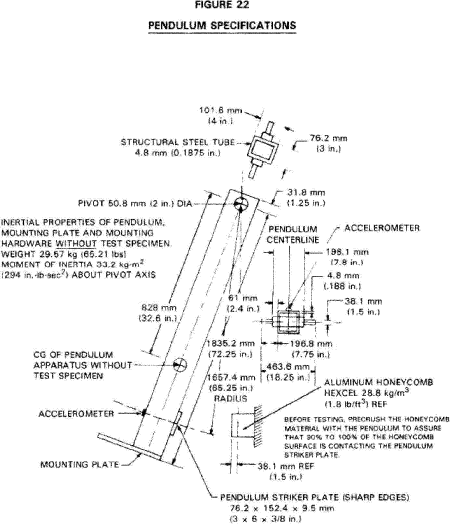Title 49
SECTION 572.33
572.33 Neck.
§ 572.33 Neck.(a) The neck consists of the assembly shown in drawing 78051-90, revision A and conforms to each of the drawings subtended therein.
(b) When the head and neck assembly (consisting of the parts 78051-61X, revision C; -90, revision A; -84; -94; -98; -104, revision F; -303, revision E; -305; -306; -307, revision X) which has a six axis neck transducer (Drawing number C-1709, Revision D, titled “Neck transducer,” dated February 1, 1993.) installed in conformance with § 572.36(d), is tested in accordance with paragraph (c) of this section, it shall have the following characteristics:
(1) Flexion. (i) Plane D, referenced in Figure 20, shall rotate between 64 degrees and 78 degrees, which shall occur between 57 milliseconds (ms) and 64 ms from time zero. In first rebound, the rotation of Plane D shall cross 0 degrees between 113 ms and 128 ms.
(ii) The moment measured by the six axis neck transducer (drawing C-1709, revision D) about the occipital condyles, referenced in Figure 20, shall be calculated by the following formula: Moment (lbs-ft) = My−0.058 × Fx, where My is the moment measured in lbs-ft by the “Y” axis moment sensor of the six axis neck transducer and Fx is the force measured in lbs by the “X” axis force sensor (Channel Class 600) of the six axis neck transducer. The moment shall have a maximum value between 65 lbs-ft and 80 lbs-ft occurring between 47ms and 58 ms, and the positive moment shall decay for the first time to 0 lb-ft between 97 ms and 107 ms.
(2) Extension. (i) Plane D, referenced in Figure 21, shall rotate between 81 degrees and 106 degrees, which shall occur between 72 ms and 82 ms from time zero. In first rebound, rotation of Plane D shall cross 0 degrees between 147 ms and 174 ms.
(ii) The moment measured by the six axis neck transducer (drawing C-1709, revision D) about the occipital condyles, referenced in Figure 21, shall be calculated by the following formula: Moment (lbs-ft) = My−0.058 × Fx, where My is the moment measured in lbs-ft by the “Y” axis moment sensor of the six axis neck transducer and Fx is the force measured in lbs by the “X” axis force sensor (Channel Class 600) of the six axis neck transducer. The moment shall have a maximum value between - 39 lbs-ft and -59 lbs-ft, occurring between 65 ms and 79 ms, and the negative moment shall decay for the first time to 0 lb-ft between 120 ms and 148 ms.


(c) Test procedure. (1) Soak the test material in a test environment at any temperature between 69 degrees F to 72 degrees F and at a relative humidity from 10% to 70% for a period of at least four hours prior to its application in a test.
(2) Torque the jamnut (78051-64) on the neck cable (78051-301, revision E) to 1.0 lbs-ft ±.2 lbs-ft.
(3) Mount the head-neck assembly, defined in paragraph (b) of this section, on a rigid pendulum as shown in Figure 22 so that the head's midsagittal plane is vertical and coincides with the plane of motion of the pendulum's longitudinal axis.

(4) Release the pendulum and allow it to fall freely from a height such that the tangential velocity at the pendulum accelerometer centerline at the instance of contact with the honeycomb is 23.0 ft/sec ±0.4 ft/sec. for flexion testing and 19.9 ft/sec. ±0.4 ft/sec. for extension testing. The pendulum deceleration vs. time pulse for flexion testing shall conform to the characteristics shown in Table A and the decaying deceleration-time curve shall first cross 5g between 34 ms and 42 ms. The pendulum deceleration vs. time pulse for extension testing shall conform to the characteristics shown in Table B and the decaying deceleration-time curve shall cross 5g between 38 ms and 46 ms.
Table A - Flexion Pendulum Deceleration vs. Time Pulse
| Time (ms) | Flexion deceleration level (g) |
|---|---|
| 10 | 22.50-27.50 |
| 20 | 17.60-22.60 |
| 30 | 12.50-18.50 |
| Any other time above 30 ms | 29 maximum. |
Table B - Extension Pendulum Deceleration vs. Time Pulse
| Time (ms) | Extension deceleration level (g) |
|---|---|
| 10 | 17.20-21.20 |
| 20 | 14.00-19.00 |
| 30 | 11.00-16.00 |
| Any other time above 30 ms | 22 maximum. |
(5) Allow the neck to flex without impact of the head or neck with any object during the test.
[51 FR 26701, July 25, 1986, as amended at 53 FR 8765, Mar. 17, 1988; 62 FR 27514, May 20, 1997; 76 FR 31864, June 2, 2011]